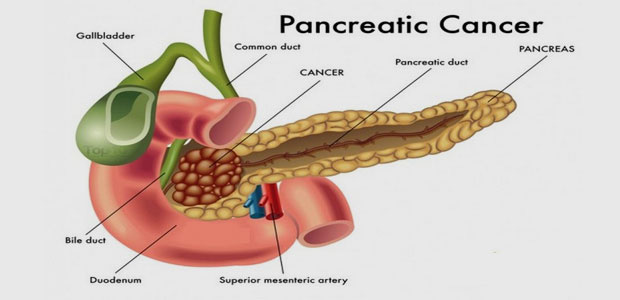Treating pancreatic cancer in St. Stamford Modern Cancer Hospital Guangzhou
In St. Stamford Modern Cancer Hospital Guangzhou, we provide pancreatic cancer patients with 18 advanced anticancer technologies and high quality services, and we will try our best to help them improve their living quality, relieve their pain and prolong their survival time. The MDT (Multidisciplinary Team) of St. Stamford Modern Cancer Hospital Guangzhou will make therapeutic plan for pancreatic cancer patients based on their condition. Combining minimally invasive therapies with historic traditional Chinese medicine, pancreatic cancer patients can avoid the suffering of traditional operation, chemotherapy and radiotherapy. Meanwhile, experts will monitor the whole treatment, and adjust timely to improve the efficacy.
We can offer help if you are diagnosed with pancreatic cancer. Online appointment or telephone appointment: 010 2066616. Contact us now.

What is pancreatic cancer?
The pancreas has both functions of endocrine secretion and exocrine secretion. Cancer that starts in the endocrine cells is called neuroendocrine tumor, by which Steve Jobs has been killed. Neuroendocrine tumor is not very common and with low degree of malignancy but long course of disease and its treatment is quite different from other common pancreatic cancers. Cancer that starts in the exocrine cells is the commonly known pancreatic cancer. It is a cancer with high degree of malignancy.
The worldwide incidence of pancreatic cancer is in a rising trend. It mostly happens among the mid-aged and old people with a higher percentage among males than females. The high risk age of pancreatic cancer is from 40 to 65, with a tendency to become younger. Pancreatic cancer has high degree of malignancy. Averagely, there is only 5-month survival after diagnosis, while in a whole, 5-year survival only accounts for 5%. Thus, pancreatic cancer gains its name “king of cancer”. Only 15%-20% patients can be treated with surgery, among which 40% of them are detected with transfusion and their survival rate after surgery is 10% only.
How does pancreatic cancer occur?
About the risk factors of pancreatic cancer, there is no clear explanation yet. However, as the researches process, many factors are found related to pancreatic cancer, including:
Smoking: people who smoke have more than 3 times risk as high as those who do not smoke.
Diet containing high protein, fat, calories: both famous Italian tenor Luciano Pavarotti and Hong Kong artist Shen Dianxia died of pancreatic cancer due to their diet containing high level of protein, fat and calories.
Diabetes: diabetes patients are in high risk of pancreatic cancer.
Chronic pancreatitis: Chronic pancreatitis can develop into pancreatic cancer
High risk group of pancreatic cancer
These people who are more than 40 years old, are also obese, and with unhealthy life habit, for example, frequent smoking and drinking and like diet high in protein, fat and calories.
Symptoms like having diarrhea once take in fatty foods, especially with oil on stools, probably indicate that the exocrine secretion function of the pancreas has been damaged.
Youths without family history are unexpectedly attacked by diabetes. That may be a sign of pancreatic cancer. For diabetes patients with a history of more than 5 years, their risk of pancreatic cancer is 1.2 times as high as that of normal people.
Symptoms of pancreatic cancer
Upper abdominal pain and inexplainable suffocating feeling, which sometimes slight, some times severe, occasional, but obvious at night. Have jaundice, but no disease like gallstones.
Apparent weight loss: although stomach cancer patients also have weight loss due to digestive and absorptive obstruction, but it is not as obvious as that of pancreatic cancer.
Recently have steatorrhea or suddenly worsening of diabetes.
If a pancreatic cancer patient is permitted to have radical surgery in the early stage, 5-year survival rate is up to 70%. Compared with pancreatic cancer in progressing stage, the treatment effect of early pancreatic cancer is quite different. Therefore, when symptoms occur, patients should go to the hospital for thorough diagnosis and timely treatment.
Pancreatic cancer screening
Generally, people with suspect of having pancreatic cancer should take non-invasive examination methods as the first choice for screening, for example, serologic tumor marker tests and stool sample tests. For those who are suspected with pancreatic cancer, diagnostic examination of pancreatic cancer should be performed.
Diagnosis of pancreatic cancer
Ultrasound examination: it can reveal the internal structure of the pancreas and whether there is obstruction in the biliary tract.
CT:plain CT can roughly reveal size and location of the lesion but cannot accurately determine its nature while enhanced CT scan can better reveal size, location, shape, internal structure and its relation with surrounding structure. CT scan can more accurately determine whether there is liver metastasis and lymph node swelling.
MRI and MRCP examination: when there are some pathological changes that are difficult to diagnose, MRI can be performed as an additional examination of CT scans to make up the shortcoming of CT images.
Staging of pancreatic cancer
Stage 1: Cancer only can be found in the pancreas, 5-year average survival rate is about 30%;
Stage 2: Cancer invades only the nearby tissues, for example, duodenal wall, 5-year average survival rate is about 10%;.
Stage 3: Regional lymph node metastasis occurs, mean survival time is 8-12 months;
Stage 4: Liver and other distant metastasis occur, mean survival time is 3-6 months.
Treatment methods for pancreatic cancer
Surgery: Pancreatoduodenectomy, pancreatoduodenectomy with pylorus retained, pancreectomy, semi-pancreectomy of left pancreas, etc.
Comprehensive treatment: with surgical treatment as leading treatment and radiation therapy and chemotherapy as supplementary treatment.
Chinese medicine treatment: by oral intake or intra-arterial infusion of Chinese medicine to control cancer. Chinese medicine can effectively nurse and balance body functions to improve the patient's immunity. It is of no side-effect, non-invasive and has special advantage in treating advanced pancreatic cancer. Using Chinese medicine combined with Western medicine in comprehensively treating early pancreatic cancer and long-term nursing after treatment can get better effect.
Nursing of pancreatic cancer
Mental nursingEstablish confidence of defeating disease and keep an optimistic attitude. Join a rehabilitation group and adjust both mental and physical condition.
Life nursingPay attention to building up a proper dietary structure Take Chinese medicine treatment for rehabilitation and combine Chinese medicine with other therapies to strengthen the treatment effect. Regular recheck.
What kinds of supports can be obtained?
Study proved that a multi-disciplinary medical group, which is composed of surgical oncology, medical oncology, department of traditional Chinese medicine, pathology department, department of radiology, anesthetist and professional nurses, can make a more effective, more suitable and more economical treatment plan so as to improve the effect of cancer treatment.
Modern Cancer Hospital Guangzhou, with its multi-disciplinary "one-stop" medical system, offers comprehensive diagnosis and treatment services to patients. It not only offers patients with all-round considerate medical services, but also improves the medical efficiency and level without increasing patient’s burden. Communication channels between patients and doctors are various, which include online consultation, email, on-phone communication and face-to-face communication. All these communication channels allow patients to enjoy the service of consultation and help them fight against cancers. Medical groups and services patients include doctors, nurses, dietitians and interpreters, by whom all levels of needs of patients from different countries can be met. Under this smooth communication environment, patients can peacefully cooperate with the treatments.






 Telephone:
Telephone: